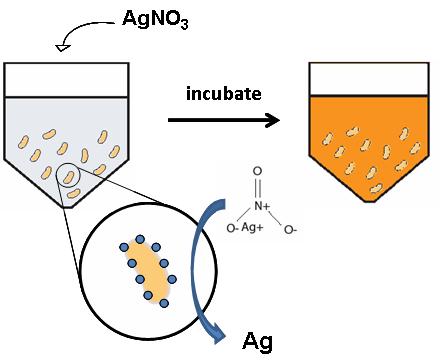Team:Berkeley Wetlab/Passenger: Ag4 Peptide
From 2009.igem.org
Susanychen (Talk | contribs) |
Susanychen (Talk | contribs) |
||
| (34 intermediate revisions not shown) | |||
| Line 1: | Line 1: | ||
| - | ==AgNO3 Reduction== | + | {{newtemplateBerkeley}} |
| + | __NOTOC__ | ||
| + | ==Ag4 Peptide== | ||
| + | Various peptides have been previously shown to mediate inorganic crystal growth and shape. It is hypothesized that these peptides interact with small metal clusters in solution to produce a chemically reducing environment for ion reduction. Moreover, peptide interactions lowers the surface energy of formed crystals to accelerate cluster formation. | ||
| + | |||
| + | The Ag4 peptide is a small 12 amino acid peptide (NPSSLFRYLPSD) demonstrated to bind and reduce silver. The surface display of this peptide has the potential of inorganic material synthesis via mimicking the recognition and nucleation properties found in natural biomineralization processes. In cell surface display, there is the additional advantage of self-replicating cells that serve as both a continual factory of silver particle synthesis and the scaffold that supplies a matrix for the synthesized materials. | ||
| + | |||
| + | |||
| + | ==Functional Assay: AgNO3 Reduction== | ||
| + | |||
| + | '''This assay tests for the presence of the AG4 silver binding peptide on the E. coli cell surface, and its ability to bind and reduce silver'''<br> | ||
| + | |||
| + | [[Image:Ag4 peptide illustration.jpg|center]]<br> | ||
| + | |||
| + | '''basic theory behind experiment''' - | ||
| + | Incubating the cells expressing silver nitrate allows for reduction of the silver ions to silver. The reddish colorimetric change observed is the result of a size-dependent characteristic surface plasmon resonance band, which has an absorption at approximately 440nm. This phenotype is readily visible for qualitative analysis. | ||
| - | |||
'''constructs:''' | '''constructs:''' | ||
AG4 peptide (8) | AG4 peptide (8) | ||
1363 negative control (1) | 1363 negative control (1) | ||
| - | |||
| - | |||
''Initially verified: AgNO3 does not react with LB or TBS'' | ''Initially verified: AgNO3 does not react with LB or TBS'' | ||
| - | ===growing cells=== | + | ====growing cells==== |
#inoculate cells from stock into LB with the appropriate antibiotics and grow to saturation (12+ hours) | #inoculate cells from stock into LB with the appropriate antibiotics and grow to saturation (12+ hours) | ||
#dilute culture 1:100 into media with arabinose and induce for 5-12hours | #dilute culture 1:100 into media with arabinose and induce for 5-12hours | ||
| - | # pipet 100ul of cells to Costar V-bottom polystyrene plate and take OD | + | #pipet 100ul of cells to Costar V-bottom polystyrene plate and take OD |
====Wash cells and incubate in AgNO3==== | ====Wash cells and incubate in AgNO3==== | ||
#pipet 2mls of culture into a 24-well block | #pipet 2mls of culture into a 24-well block | ||
| - | # | + | #pellet the saturated induced culture |
| - | # | + | #pour out the supernatant |
| - | #wash cells with 200ul of TBS | + | #wash cells 2X with 200ul of TBS |
====Treating with Silver==== | ====Treating with Silver==== | ||
| - | # | + | #make 10mM stock of AgNO3 |
| - | # | + | #add 200uL, 1ml, and 2ml of 0.1 mM silver nitrate and resuspend the cells (add 180 ul of TBS to each pellet, resuspend cells, add 20 ul of 1 mM AgNO3) |
| - | + | #incubate overnight at room temperature | |
| - | + | #observe color change and precipitate formation | |
| - | + | #take pictures with TEM | |
| - | + | ||
| - | + | ||
| - | + | ||
| - | + | ||
| - | + | ||
| - | + | ||
| - | + | ||
| - | + | ||
| - | + | ||
| - | + | ||
| - | + | ||
| - | + | ||
| - | + | ||
| - | + | ||
| - | + | ||
| - | + | ||
| - | + | ||
| - | + | ||
| - | + | ||
| - | + | ||
| - | + | ||
| - | + | ||
| - | + | ||
| - | # | + | |
| - | #observe color change and | + | |
| - | + | ||
| - | + | ||
| - | + | ||
| - | + | ||
| - | # | + | |
| - | + | ||
| - | + | ||
| - | + | ||
| - | + | ||
| - | + | ||
| - | + | ||
| - | + | ||
| - | + | ||
| - | + | [https://2009.igem.org/Recipes TBS recipe] | |
| - | + | ||
| - | ==== | + | ==Results== |
| + | [[Image:050609results table.jpg]] <br> | ||
| + | note: the color that appeared were in solution, not in precipitate form. <br> Also, the lack of color from constructs 11-14 might be because of small volumes since previous experiment had shown color and precipitate. | ||
| - | + | 11 - {<CPG_L6!}<br> | |
| - | + | 12 - {<eCPX!}<br> | |
| - | + | 13 - {<upaG_short!}<br> | |
| + | 14 - {<Ag43_short!}<br> | ||
| + | 15 - {<espP(beta)!}<br> | ||
| + | 16 - {<ehaB!]<br> | ||
| + | 17 - {<CPompX!}<br> | ||
| - | |||
| - | + | [[Image:Control2ml.JPG|200px]] [[Image:15 2ml.JPG|200px]] [[Image:16 2ml.JPG|200px]] [[Image:17 2ml.JPG|200px]] <br> | |
| - | + | negative control 1363, espP(beta) (15), ehaB (16), CPompX (17) <br> | |
| - | + | ||
| - | |||
| - | + | [[Image:050609results Tecan3.jpg|700px]] <br> | |
| - | + | <font color="darkblue">control</font> <br> | |
| - | + | <font color="magenta">espP(beta)</font> <br> | |
| - | + | <font color="gold">ehaB</font> <br> | |
| - | + | <font color="turquoise">CPompX</font> <br> | |
| - | + | Absorbance around 440nm-500nm was observed most noticeably for espP(beta). To get rid of the scattering signal, cells were spun down, and this graph was generated using the respective supernatants. The formation of silver particles gives a characteristic surface plasmon resonsance around 440nm - 500nm. The visible colorimetric changes are confirmed by the UV-Spec readings. | |
| - | + | ||
| - | |||
| - | + | ===References=== | |
| - | + | Rajesh, R. et al. Biomimetic synthesis and patterning of silver nanoparticles. Nature Materials. October 2002; (1): 169 - 172. Available Online: http://www.ncbi.nlm.nih.gov/pmc/articles/PMC2620822/ (Accessed: 20 October 2009). | |
| - | + | ||
| - | + | ||
Latest revision as of 02:42, 22 October 2009
Ag4 Peptide
Various peptides have been previously shown to mediate inorganic crystal growth and shape. It is hypothesized that these peptides interact with small metal clusters in solution to produce a chemically reducing environment for ion reduction. Moreover, peptide interactions lowers the surface energy of formed crystals to accelerate cluster formation.
The Ag4 peptide is a small 12 amino acid peptide (NPSSLFRYLPSD) demonstrated to bind and reduce silver. The surface display of this peptide has the potential of inorganic material synthesis via mimicking the recognition and nucleation properties found in natural biomineralization processes. In cell surface display, there is the additional advantage of self-replicating cells that serve as both a continual factory of silver particle synthesis and the scaffold that supplies a matrix for the synthesized materials.
Functional Assay: AgNO3 Reduction
This assay tests for the presence of the AG4 silver binding peptide on the E. coli cell surface, and its ability to bind and reduce silver
basic theory behind experiment - Incubating the cells expressing silver nitrate allows for reduction of the silver ions to silver. The reddish colorimetric change observed is the result of a size-dependent characteristic surface plasmon resonance band, which has an absorption at approximately 440nm. This phenotype is readily visible for qualitative analysis.
constructs:
AG4 peptide (8)
1363 negative control (1)
Initially verified: AgNO3 does not react with LB or TBS
growing cells
- inoculate cells from stock into LB with the appropriate antibiotics and grow to saturation (12+ hours)
- dilute culture 1:100 into media with arabinose and induce for 5-12hours
- pipet 100ul of cells to Costar V-bottom polystyrene plate and take OD
Wash cells and incubate in AgNO3
- pipet 2mls of culture into a 24-well block
- pellet the saturated induced culture
- pour out the supernatant
- wash cells 2X with 200ul of TBS
Treating with Silver
- make 10mM stock of AgNO3
- add 200uL, 1ml, and 2ml of 0.1 mM silver nitrate and resuspend the cells (add 180 ul of TBS to each pellet, resuspend cells, add 20 ul of 1 mM AgNO3)
- incubate overnight at room temperature
- observe color change and precipitate formation
- take pictures with TEM
Results

note: the color that appeared were in solution, not in precipitate form.
Also, the lack of color from constructs 11-14 might be because of small volumes since previous experiment had shown color and precipitate.
11 - {<CPG_L6!}
12 - {<eCPX!}
13 - {<upaG_short!}
14 - {<Ag43_short!}
15 - {<espP(beta)!}
16 - {<ehaB!]
17 - {<CPompX!}
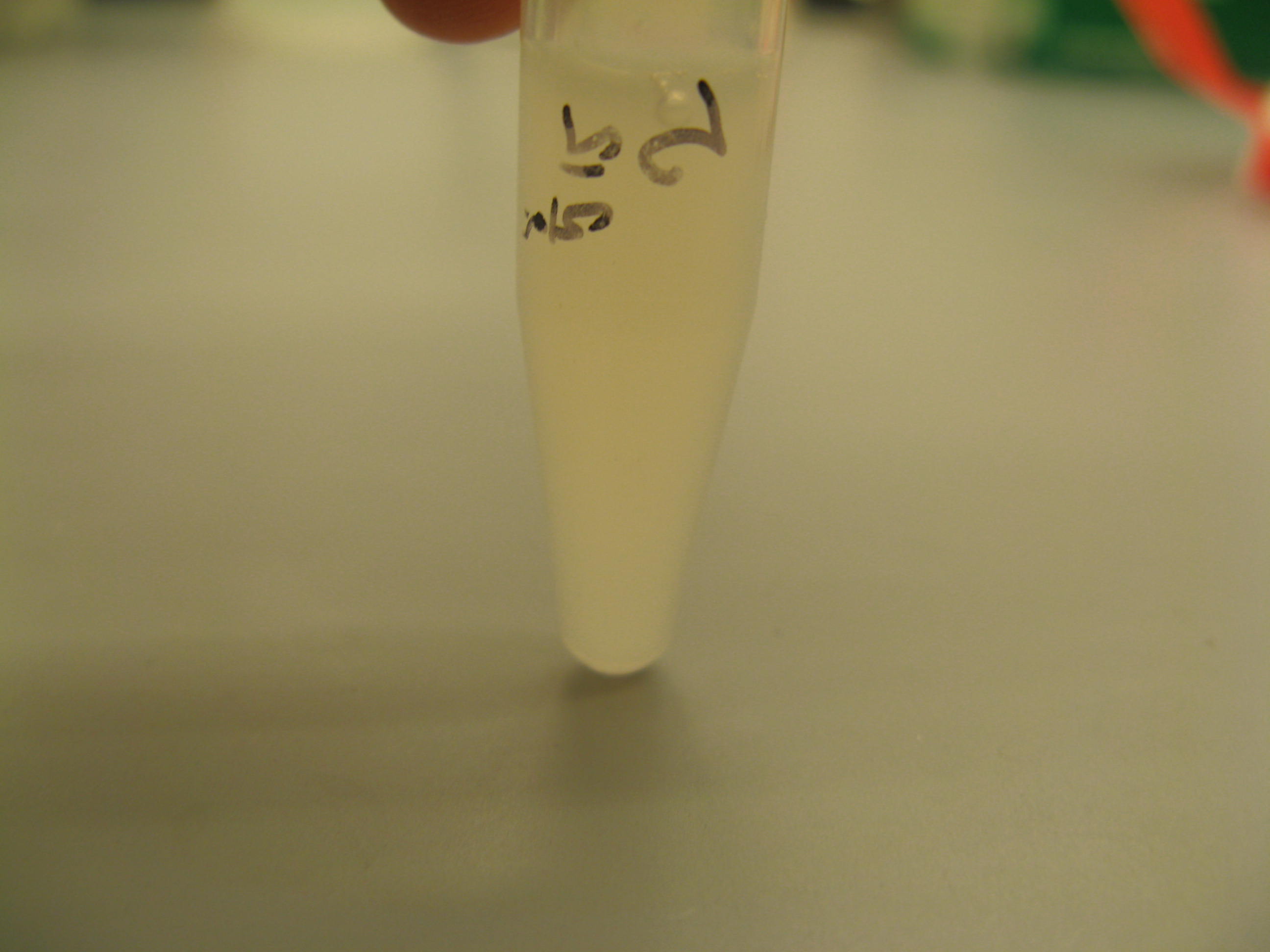
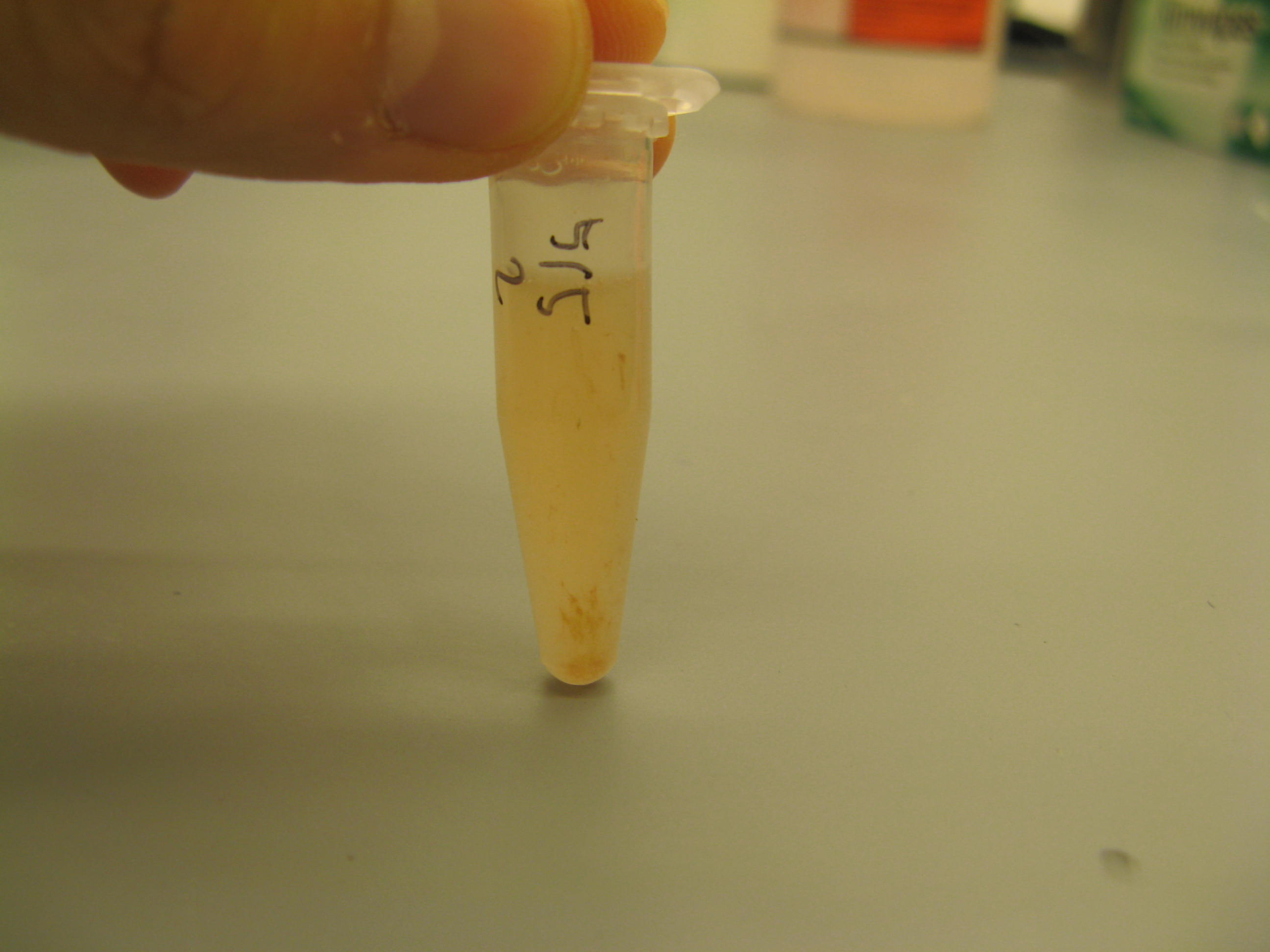
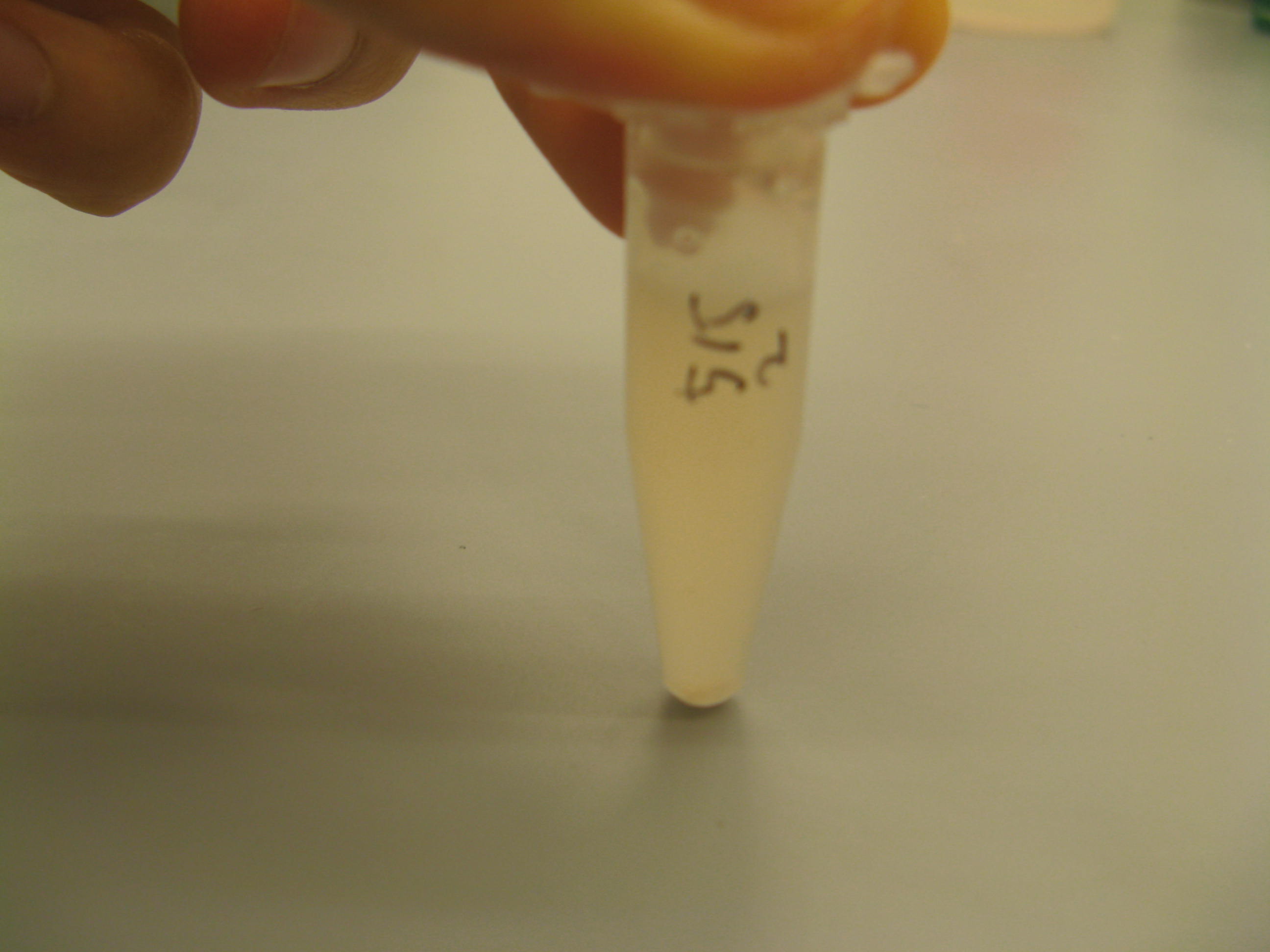

negative control 1363, espP(beta) (15), ehaB (16), CPompX (17)
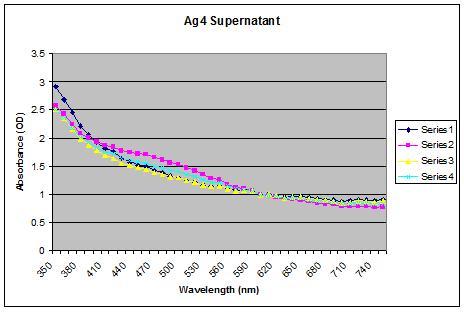
control
espP(beta)
ehaB
CPompX
Absorbance around 440nm-500nm was observed most noticeably for espP(beta). To get rid of the scattering signal, cells were spun down, and this graph was generated using the respective supernatants. The formation of silver particles gives a characteristic surface plasmon resonsance around 440nm - 500nm. The visible colorimetric changes are confirmed by the UV-Spec readings.
References
Rajesh, R. et al. Biomimetic synthesis and patterning of silver nanoparticles. Nature Materials. October 2002; (1): 169 - 172. Available Online: http://www.ncbi.nlm.nih.gov/pmc/articles/PMC2620822/ (Accessed: 20 October 2009).
 "
"







